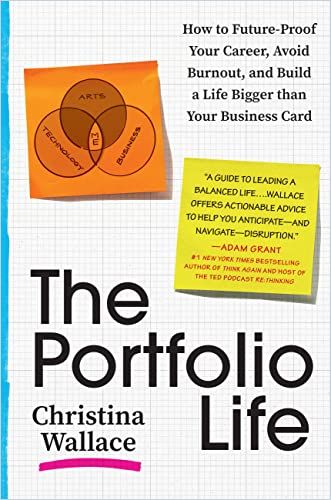Senior lecturer of entrepreneurial management at Harvard Business School Christina Wallace details how and why you should embrace a diverse, multifaceted career path.

Diversify Your Career
A traditional career path follows a linear trajectory: climbing the corporate ladder within a field or industry. This model proves less profitable – or even workable – in today’s constantly changing, unpredictable and nonlinear job market, asserts Christina Wallace, senior lecturer of entrepreneurial management at Harvard Business School and co-host of The Limit Does Not Exist podcast. She warns that new technologies and automation, such as AI, disrupt industries, eliminating certain jobs while creating others – some previously unseen.
Never allow your work or job title to define you and your life’s purpose. Find that purpose in a broader range of personal, professional and relational goals.
How did you get to be here? / What was the moment? Stephen Sondheim
Take a new view of your future opportunities and possible paths to success: the “Portfolio Life.” In the Portfolio model, work-life balance includes professional diversification, embracing relationships and pursuing personal growth. A portfolio life grants you the freedom to pursue your passions and create a life of happiness and purpose today – not 20 years from now when you retire from corporate life.
Redefine your sense of self beyond your profession, Wallace urges. Recognize that your identity is multifaceted and that your passions and skills likely overlap. Regard yourself – accurately – as a collection of talents, experiences and drives. Don’t box yourself into one career path. Create more options to generate multiple income streams and pursue diverse projects across every field that compels you.
Flexibility gives you freedom. Never limit yourself or believe you are less complex than you are. Stay open to change. Regarding yourself as a collection of skills and talents gives you a more optimistic view toward changing jobs. The idea of failing and having to try again becomes less fearsome as you gain confidence in your ability to adapt and grow.
Time and Money
Regard your career as a business model that lays out the essential framework for a successful business, including revenue sources, costs, logistics and resources.
There are various approaches to creating a business model for your career. For example, consider the options you might pursue while building a writing career. One extreme involves becoming a full-time author and relying on sporadic – though significant – income from manuscript sales. The other end of the spectrum entails taking a job that features consistent writing assignments and predictable revenue, such as being a journalist. Writing can be a part-time gig or a side project, offering different pay, work schedules, flexibility, inspiration and opportunities.
You make yourself as you go. Keep moving.Maggie Smith
You can apply three different business models to your career:
The “Moonlighting” model allows you to pursue additional endeavors that align with your passions and interests. The “Zigzaggers” model lets you embrace a nonlinear career path characterized by diverse experiences, transitions and explorations of different fields. Zigzagging challenges the notion that career success means following a single, upward progression and encourages you to pursue the unknown. The “Multihyphenates” model works best for people seeking to capitalize on their multifaceted identities or simultaneously pursue multiple roles or professions. Multihyphenates integrate their varied skills and interests into their portfolio careers. They combine functions such as entrepreneur-artist-writer or consultant-teacher-photographer to embrace their diverse talents and passions while creating a fulfilling, purpose-driven life.
A Diverse Network
Gather a team of people who support you, Wallace writes. Having strong relationships helps you build your portfolio life by better enabling you to pursue multiple interests and careers. A diverse network of people from different industries with differing areas of interest opens up a more comprehensive range of opportunities.
When creating your network, focus on diversity. Look for outliers and pursue them. Your team or network should include a “coach,” “negotiator,” “cheerleader,” “connector” and “truth teller.” Your coach helps you reach your potential while providing guidance and advice. Your negotiator works in your industry, has experience negotiating salaries, and is up-to-date on the latest job market trends. Your cheerleader may be a close friend who gives you comfort and encouragement when you need it most. Your connector knows everyone and helps introduce you to them. Your truth teller will call you out on mistakes to help you progress toward becoming the best version of yourself.
Whatever story you present to prospective clients or employers, highlight the problems you can solve. Don’t sell yourself as a product; sell yourself as a solution. This proves especially helpful if you’ve had many job titles because it highlights your skills and how your skills can help the person or company looking to hire you.
Stability, Sustainability and Freedom
Avoid making your life entirely about your work. Take time for what makes you happy.
How we spend our days is, of course, how we spend our lives. What we do with this hour, and that one, is what we are doing. Annie Dillard
Wallace urges you to assess your skills, time availability and energy levels each day. Set realistic goals and manage commitments to avoid overextending yourself.
Determine the pivotal tasks you must complete to accomplish a goal. Identify and prioritize the most important steps to streamline your efforts, allocate resources effectively and focus on what matters. Set aside designated periods for rest and rejuvenation. Consciously create moments of relaxation, leisure and self-care as a proactive strategy for maintaining your well-being and sustaining productivity.
The Blueprint
Christina Wallace, accustomed to providing real-world, practical advice to her students in entrepreneurial management at Harvard’s Business School, writes on a perhaps unexpected subject. Her career guidance is somewhat general and addresses embracing a mind-set suited to today’s work arena – and tomorrow’s. Rather than detail business management methods, Wallace vests in forms of self-management that stand apart from most of the self-help approaches that appear in parallel works. Wallace wants you to believe in yourself in all your multiplicity and to find work opportunities that reflect, honor and monetize that complex selfhood. Her straightforward, applicable advice likely best suits recent graduates and anyone feeling stuck in a mid-career rut.





